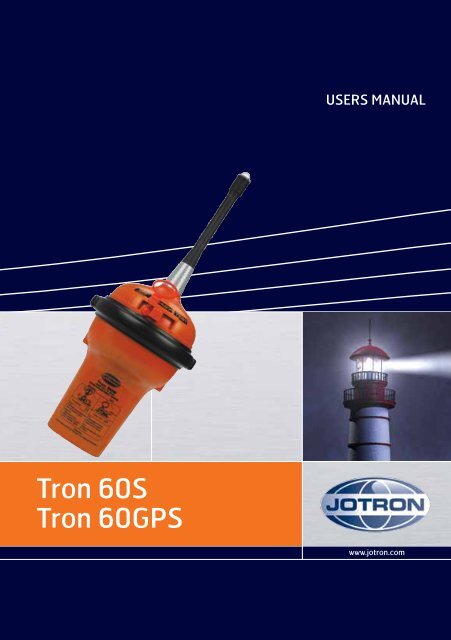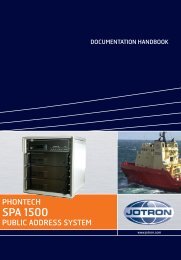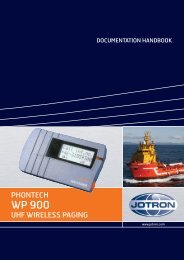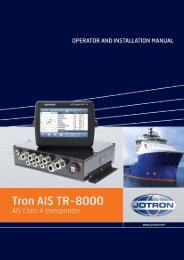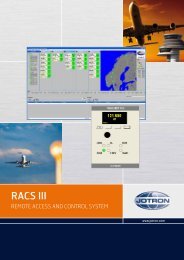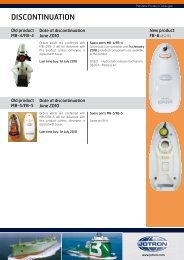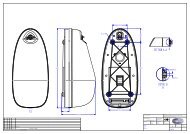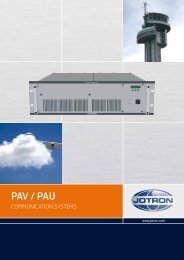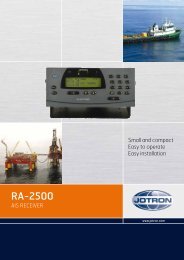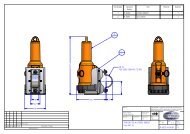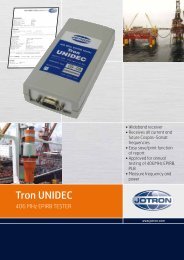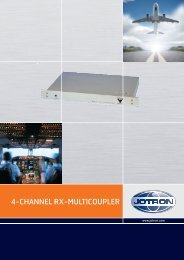Tron 60S Tron 60GPS - Jotron
Tron 60S Tron 60GPS - Jotron
Tron 60S Tron 60GPS - Jotron
Create successful ePaper yourself
Turn your PDF publications into a flip-book with our unique Google optimized e-Paper software.
USERS MANUAL<br />
<strong>Tron</strong> <strong>60S</strong><br />
<strong>Tron</strong> <strong>60GPS</strong><br />
www.jotron.com
www.jotron.com<br />
Amendment records<br />
Amendment<br />
By Date Page(s) Vers. Reason for change<br />
no<br />
1 TH 23.12.2010 Total 32 A New Manual<br />
2 TH 25.02.2011 Ch. 3.1.2 B Changed battery<br />
info<br />
3 TH 18.04.2011 Page 13-29 C Re-arranged pictures/drawings<br />
4 TH 19.09.2011 Page 15, D Info update<br />
22-25<br />
5 BR 10.11.2011 Page 24 E Info update on test<br />
6 TH 20.01.2012 Page 16-18,<br />
30<br />
7 ØE 08.02.2012 6,16, 18, 20,<br />
22 and 24<br />
F<br />
G<br />
Update text and<br />
images<br />
Update text<br />
8 TH H Text and pictures<br />
9 FIT 22.05.2012 6, 12, 16, 18, I Updated text<br />
26, 29-30<br />
10 BR 26.06.2012 6, 16 J Battery info and<br />
EPIRB registration<br />
11 ØE 16.10.2012 15-16 K EPIRB registration<br />
2<br />
85525_UM_<strong>60S</strong>/GPS_K
www.jotron.com<br />
EC Declaration of Conformity, available at www.jotron.com<br />
Abbreviations and definitions<br />
BAUD<br />
Transmission rate unit of measurement for binary coded data (bit per second)<br />
BIT<br />
Short form of Binary Digit. The smallest element of data in a binary-coded value<br />
BPS<br />
Bits Per Second<br />
COSPAS<br />
COsmicheskaya Sistyema Poiska Avariynich Sudov (Space System for the<br />
Search of Vessels in Distress)<br />
EPIRB<br />
Emergency Position Indicating Radio Beacon<br />
GLOBAL POSITIONING SYSTEM (GPS)<br />
The NAVSTAR Global Positioning System, which consists of orbiting satellites, a<br />
network of ground control stations, and user positioning and navigation equipment.<br />
The system has 24 satellites plus 3 active spare satellites in six orbital<br />
planes about 20,200 kilometers above the earth.<br />
IEC<br />
International Electro-technical Commission<br />
IMO<br />
International Maritime Organization<br />
IBRD<br />
International 406MHz Beacon Registration Database<br />
ITU<br />
International Telecommunication Union<br />
85525_UM_<strong>60S</strong>/GPS_K<br />
3
www.jotron.com<br />
LED<br />
Light Emitting Diode<br />
LUT<br />
Local User Terminal (Ground Station)<br />
MCA<br />
Marine and Coastguard Agency (UK)<br />
MCC<br />
Mission Control Centre<br />
NOAA<br />
National Oceanic and Atmospheric Administration (USA)<br />
RCC<br />
Rescue Coordination Centre<br />
SARSAT<br />
Search and Rescue Satellite-Aided Tracking System<br />
SBM<br />
Shore Based Maintenance – as required by SOLAS regulation IV/15.9.2 of<br />
SOLAS 1974 as amended with, in accordance with MSC/Circ. 1039 guidelines for<br />
Shore-Based Maintenance (SBM) of Satellite EPIRBs within 5 years if:<br />
Passenger ships (> 12 passengers) and cargo ships (> 300GT) engaged in International<br />
voyages, shall perform SBM as follows:<br />
• Latest by the date of the EPIRB label with this text, or the battery Label,<br />
whichever is first<br />
• When this EPIRB becomes due for SBM in accordance with national requirements<br />
VHF<br />
Very High Frequency -A set of frequencies in the 30-300MHz region.<br />
4<br />
85525_UM_<strong>60S</strong>/GPS_K
www.jotron.com<br />
IMPORTANT<br />
The information in this book has been carefully checked and is believed to be<br />
accurate. However, no responsibility is assumed for inaccuracies.<br />
This equipment contains CMOS integrated circuits. Observe handling precautions<br />
to avoid static discharges which may damage these devices. <strong>Jotron</strong> AS<br />
reserves the right to make changes without further notice to any products or<br />
modules described herein to improve reliability, function or design. <strong>Jotron</strong> AS<br />
does not assume any liability arising out of the application or use of the described<br />
product.<br />
WARNING / IMPORTANT<br />
<strong>Jotron</strong> AS is a prime manufacturer of safety equipment designed for rescue of<br />
human lives and their property. For safety equipment to be effective in line with<br />
the design parameters it is important that they are handled, stowed and maintained<br />
in compliance with the manufacturers instructions. <strong>Jotron</strong> AS can not be<br />
held responsible for any damage caused due to incorrect use of the equipment<br />
or breach of laid down procedures or for failure of any specific component or<br />
other parts of the equipment.<br />
The chapter covering battery replacement is added for information only. <strong>Jotron</strong><br />
AS does not take any responsibility for improper disassembling/assembling of<br />
the beacon. We strongly recommend all service to be done by authorized <strong>Jotron</strong><br />
AS agents. In addition to normal service, <strong>Jotron</strong> AS agents have the necessary<br />
equipment and education to test the operational functions of the beacon. Nonoriginal<br />
maintenance and/or service parts may destroy the equipment function<br />
and performance.<br />
85525_UM_<strong>60S</strong>/GPS_K<br />
5
www.jotron.com<br />
BATTERY SAFETY DATA SHEET<br />
PRODUCT NAME:<br />
Energizer Battery<br />
TYPE NO.: L91 Volts: 1.5<br />
TRADE NAMES:<br />
APPROXIMATE WEIGHT:<br />
CHEMICAL SYSTEM:<br />
DESIGNED FOR RECHARGE:<br />
ULTIMATE (L91)<br />
14.5 g<br />
Lithium/Iron Disulfide<br />
No<br />
HAZARDS IDENTIFICATION<br />
Under normal conditions of use, the battery is hermetically sealed.<br />
Ingestion: Swallowing a battery can be harmful.<br />
Inhalation: Contents of an open battery can cause respiratory irritation.<br />
Skin Contact: Contents of an open battery can cause skin irritation.<br />
Eye Contact: Contents of an open battery can cause severe irritation.<br />
FIRST AID MEASURES<br />
Ingestion: Do not induce vomiting or give food or drink. Seek medical attention<br />
immediately. CALL NATIONAL BATTERY INGESTION HOTLINE for advice and<br />
follow-up (202-625-3333) collect day or night.<br />
Inhalation: Provide fresh air and seek medical attention.<br />
Skin Contact: Remove contaminated clothing and wash skin with soap and water.<br />
Eye Contact: Immediately flush eyes thoroughly with water for at least 15 minutes,<br />
lifting upper and lower lids, until no evidence of the chemical remains. Seek<br />
medical attention.<br />
Note: Carbon black is listed as a possible carcinogen by International Agency<br />
for Research on Cancer (IARC).<br />
FIRE FIGHTING MEASURES<br />
In case of fire where lithium batteries are present, flood area with water or<br />
smother with a Class D fire extinguishant appropriate for lithium metal, such as<br />
Lith-X. Water may not extinguish burning batteries but will cool the adjacent<br />
batteries and control the spread of fire. Burning batteries will burn themselves<br />
out. Virtually all fires involving lithium batteries can be controlled by flooding<br />
6<br />
85525_UM_<strong>60S</strong>/GPS_K
www.jotron.com<br />
with water. However, the contents of the battery will react with water and form<br />
hydrogen gas. In a confined space, hydrogen gas can form an explosive mixture.<br />
In this situation, smothering agents are recommended. A smothering agent will<br />
extinguish burning lithium batteries.<br />
Emergency Responders should wear self-contained breathing apparatus. Burning<br />
lithium-iron disulfide batteries produce toxic and corrosive lithium hydroxide<br />
fumes and sulfur dioxide gas.<br />
HANDLING AND STORAGE<br />
Storage: Store in a cool, well ventilated area. Elevated temperatures can result<br />
in shortened battery life. In locations that handle large quantities of lithium batteries,<br />
such as warehouses, lithium batteries should be isolated from unnecessary<br />
combustibles.<br />
Mechanical Containment: If potting or sealing the battery in an airtight or watertight<br />
container is required, consult your Energizer Battery Manufacturing, Inc.<br />
representative for precautionary suggestions. Do not obstruct safety release<br />
vents on batteries. Encapsulation of batteries will not allow cell venting and can<br />
cause high pressure rupture.<br />
Handling: Accidental short circuit for a few seconds will not seriously affect the<br />
battery. Prolonged short circuit will cause the battery to lose energy, generate<br />
significant heat and can cause the safety release vent to open. Sources of short<br />
circuits include jumbled batteries in bulk containers, metal jewelry, metal covered<br />
tables or metal belts used for assembly of batteries into devices. Damaging<br />
a lithium battery may result in an internal short circuit.<br />
• The contents of an open battery, including a vented battery, when exposed<br />
to water, may result in a fire and/or explosion. Crushed or damaged batteries<br />
may result in a fire.<br />
• If soldering or welding to the battery is required, consult your Energizer representative<br />
for proper precautions to prevent seal damage or short circuit.<br />
Charging: This battery is manufactured in a charged state. It is not designed for<br />
recharging. Recharging can cause battery leakage or, in some cases, high pressure<br />
rupture. Inadvertent charging can occur if a battery is installed backwards.<br />
Labeling: If the Energizer label or package warnings are not visible, it is important<br />
to provide a package and/or device label stating:<br />
85525_UM_<strong>60S</strong>/GPS_K<br />
7
www.jotron.com<br />
- WARNING:<br />
Battery can explode or leak and cause burns if installed backwards, disassembled,<br />
charged, or exposed to water, fire or high temperature. Where accidental<br />
ingestion of small batteries is possible, the label should include:<br />
- WARNING:<br />
(1) Keep away from small children. If swallowed, promptly see doctor. Battery can<br />
explode or leak and cause burns if installed backwards, disassembled, charged,<br />
or exposed to water, fire or high temperature.<br />
Test and maintenance record<br />
DATE N/T/B SIGN INSP<br />
N= New EPIRB installed, T= Test, B= New battery<br />
TEST OF RADIO EQUIPMENT<br />
Monthly:<br />
Float-free and manual EPIRBs to be checked using the means provided for<br />
testing on the equipment. Check data for periodical maintenance requirement<br />
for float-free EPIRB.<br />
False alerts transmitted by EPIRB<br />
False alerts are a serious problem for the rescue service. Nearly 90% of EPIRB<br />
initiated distress alerts turn out to be false alarms.<br />
If for any reason, your EPIRB should cause a false alarm, it is most important<br />
that you contact the nearest search and rescue authority and tell them it was a<br />
false alarm. They can then stand down any rescue service (coast radio station<br />
or appropriate CES or RCC). Use any means at your disposal to make contact.<br />
8<br />
85525_UM_<strong>60S</strong>/GPS_K
www.jotron.com<br />
Switch off the distress alarm by de-activating your EPIRB, as soon as possible.<br />
If your beacon is activated in a non-distress situation or a distress situation<br />
which has been resolved and you no longer require assistance, contact the<br />
nearest search and rescue authorities via the most expeditious means available<br />
with the following information:<br />
• Beacon ID number (15 character UIN):<br />
• Position (At time of activation):<br />
• Date of Activation:<br />
• Time of Activation (Time zone):<br />
• Duration of Activation:<br />
• Beacon marke and model:<br />
• Vessel Name/lD:<br />
• Circumstances/cause (if known):<br />
USA<br />
The United States search and rescue authority is the U.S. Coast Guard. The primary<br />
points of<br />
contact are:<br />
Pacific Ocean Area<br />
USCG Pacific Area Command Centre<br />
Tel: +1 (510)-437-3701<br />
Atlantic Ocean / Gulf of Mexico Area<br />
USCG Atlantic Area Command Centre<br />
Tel: +1 (757)-398-6231<br />
From Any Location<br />
USCG Headquarters Command Centre<br />
Tel: +1 (800)-323-7233<br />
85525_UM_<strong>60S</strong>/GPS_K<br />
9
www.jotron.com<br />
TABLE OF CONTENT<br />
1 GENERAL DESCRIPTION 12<br />
1.1 TRON <strong>60S</strong>/ GPS 12<br />
1.2 SYSTEM DESCRIPTION 13<br />
1.2.1 SIGNAL DETECTION 13<br />
1.2.2 DISTRESS LOCATION DETERMINATION 14<br />
1.2.3 EPIRB REGISTRATION 15<br />
2 TECHNICAL SPECIFICATIONS 18<br />
2.1 GENERAL 18<br />
2.2 COSPAS-SARSAT TRANSMITTER 18<br />
2.3 NAVIGATION DEVICE 18<br />
2.4 HOMING TRANSMITTER 18<br />
2.5 BRACKETS 19<br />
2.5.1 FLOAT FREE BRACKET FB-60 19<br />
2.5.2 MANUAL BRACKET MB-60 19<br />
3 EPIRB DESCRIPTION 20<br />
3.1 GENERAL 20<br />
3.1.1 MAIN MODULE WITH ANTENNA 20<br />
3.1.2 BATTERY PACK 20<br />
4 INSTALLATION 21<br />
4.1 BRACKETS 21<br />
4.1.1 FLOAT FREE BRACKET FB-60 21<br />
4.1.2 MANUAL BRACKET MB-60 22<br />
4.1.3 MOUNTING THE FB-60/MB-60 BRACKETS 22<br />
5 OPERATION INSTRUCTIONS 23<br />
5.1 MANUAL OPERATION 23<br />
5.1.1 OUT OF BRACKET 23<br />
5.1.2 FLOAT FREE BRACKET FB-60 24<br />
5.2 AUTOMATIC OPERATION - FLOAT FREE BRACKET FB-60 25<br />
5.3 TEST 25<br />
10<br />
85525_UM_<strong>60S</strong>/GPS_K
www.jotron.com<br />
6 PERIODICAL CONTROL 27<br />
6.1 EVERY MONTH: 27<br />
6.2 EVERY 12 TH MONTH: 27<br />
6.3 EVERY 2 ND YEAR: 27<br />
6.4 EVERY 5 TH YEAR: 27<br />
6.5 SERVICE PROCEDURE 2012 28<br />
7 MAINTENANCE 29<br />
7.1 EPIRB MODULE / BATTERY PACK 29<br />
7.1.1 CHANGE OF BATTERY 29<br />
7.2 HYDROSTATIC RELEASE REPLACEMENT 30<br />
7.2.1 REPLACING THE RELEASE MECHANISM IN 30<br />
FB-60 BRACKET<br />
8 SPARE PARTS 31<br />
9 SERVICE AGENTS 31<br />
85525_UM_<strong>60S</strong>/GPS_K<br />
11
www.jotron.com<br />
1 GENERAL DESCRIPTION<br />
The <strong>Tron</strong> <strong>60S</strong>/GPS is emergency equipment consisting of:<br />
• <strong>Tron</strong> <strong>60S</strong>/GPS Cospas-Sarsat emergency EPIRB<br />
• One of the following brackets:<br />
• FB-60 - Automatic float free bracket<br />
• MB-60 - Manual bracket<br />
The <strong>Tron</strong> <strong>60S</strong>/GPS EPIRB is developed to meet the regulations and rules for use<br />
on vessels and life rafts in the maritime service. <strong>Tron</strong> <strong>60S</strong>/GPS meets the following<br />
specifications for 406 MHz EPIRBs for use in search and rescue operations<br />
at sea.<br />
See “Declaration of Conformity” document at www.<strong>Jotron</strong>.com for information<br />
of required standards.<br />
1.1 TRON <strong>60S</strong>/ GPS<br />
The <strong>Tron</strong> <strong>60S</strong>/GPS is buoyant and have water activated contacts which will<br />
start DISTRESS transmission if deployed into water. <strong>Tron</strong> <strong>60S</strong>/GPS are currently<br />
available with two different brackets, one manual type and one float free version.<br />
Both type of brackets prevents DISTRESS transmission if water spray are<br />
applied to the EPIRBs.<br />
The Float free bracket, FB-60 is a covered bracket with an hydrostatic release<br />
unit (HRU) which will release the <strong>Tron</strong> <strong>60S</strong>/GPS if the bracket is submerged to a<br />
depth of 2-4 meters if the ship are about to sink.<br />
The Manual bracket, MB-60 is a simple bracket for those ships which does not<br />
need a float free version, or for those in need of an additional manual EPIRB<br />
in the wheelhouse as required by some national administrations. The manual<br />
bracket will also be used as a shipment bracket when <strong>Jotron</strong> send replacement<br />
units to customers.<br />
The purpose of the <strong>Tron</strong> <strong>60S</strong>/GPS is to give a primary alarm to the search<br />
and rescue authorities. The EPIRB gives an immediate alarm when activated,<br />
transmitting the ID of the ship in distress. Care must be taken not to activate<br />
the EPIRB unless in an emergency situation, in such cases the user will be held<br />
responsible. For periodic testing a test function is implemented. During the test<br />
cycle the EPIRB does a self-test on the transmitters and on the battery status.<br />
12<br />
85525_UM_<strong>60S</strong>/GPS_K
www.jotron.com<br />
No emergency signal is transmitted during the self-test.<br />
The battery of the EPIRB will last for at least 48 hours from activation of the<br />
EPIRB.<br />
1.2 SYSTEM DESCRIPTION<br />
The Cospas-Sarsat system was introduced in 1982 as a worldwide search and<br />
rescue system with the help of satellites covering the earth’s surface. Since the<br />
introduction of the system more than 28000 persons have been rescued by<br />
the Cospas-Sarsat system (2009). Currently the system consists of 5 functional<br />
satellites in a polar orbit constellation, these satellites cover the entire earth’s<br />
surface and receive the emergency signal from the 406 MHz transmitter within<br />
the <strong>Tron</strong> <strong>60S</strong>/GPS, more polar orbiting satellites will be available in the future,<br />
giving a faster location and rescue time.<br />
In addition several geostationary satellites are equipped with a 406 MHz transponder,<br />
these satellites are not able to locate the <strong>Tron</strong> <strong>60S</strong>/GPS but will give<br />
an early warning to the rescue forces, minimising the time from an emergency<br />
occurs till the rescue forces are at the site.<br />
Each emergency EPIRB in the system is programmed with its own unique code,<br />
therefore it is vital that the ships data that is given to the dealer you obtained<br />
your <strong>Tron</strong> <strong>60S</strong>/GPS, is correct. It is also important that your EPIRB is registered<br />
in the database for each country. This database is normally located in the same<br />
country that the ship is registered.<br />
1.2.1 SIGNAL DETECTION<br />
When the <strong>Tron</strong> <strong>60S</strong>/GPS is activated<br />
(manually or automatically) it transmits<br />
on the frequencies 121.5 MHz and<br />
406.037 MHz. An analogue signal is<br />
emitted on 121.5 MHz and a digital<br />
signal is transmitted on 406.037 MHz.<br />
After the <strong>Tron</strong> <strong>60S</strong>/GPS is activated,<br />
the next passing satellite will detect the<br />
transmitted signal and relay it to an antenna at a ground station, called LUT.<br />
The International Cospas-Sarsat System has ceased satellite processing of<br />
121.5/243 MHz beacons from 1 February 2009.<br />
85525_UM_<strong>60S</strong>/GPS_K<br />
13
www.jotron.com<br />
1.2.2 DISTRESS LOCATION DETERMINATION<br />
The location of the distress signal is determined by taking<br />
measurements of the doppler shift of the EPIRB frequency<br />
when the satellite first approach and then pass the EPIRB.<br />
The actual frequency is heard at the time of closest approach<br />
(TCA). Knowing the position of the satellite and using the received<br />
doppler signal information, it is possible to determine<br />
the location of the <strong>Tron</strong> <strong>60S</strong>/GPS from the satellite at the<br />
TCA. At the LUT, actually two positions are calculated. One is<br />
the actual position (A) and the other is the mirror image (B)<br />
position. A second satellite pass confirms the correct location (A). Doppleronly<br />
accuracy is within 5 km (3 mi) (3.1 statute miles or 2.6 nautical miles)— that<br />
is, the position is sufficiently accurate for SAR purposes even after only one<br />
pass. What’s more, the most likely of the two ’mirror’ positions can be determined<br />
valid with 98.5% accuracy after only one satellite pass. This accuracy can<br />
be increased to 99.3% using so-called ”combined Leo-Geo processing,” and<br />
this technique also enables accurate positions to be generated with as little as<br />
two or three bursts from the beacon (i.e. less than 4 minutes of transmission)<br />
and thus greatly increases the chances of being found even if the beacon is<br />
ultimately consumed by fire or is otherwise destroyed<br />
1.2.2.1 GPS ADVANTAGE<br />
Polar orbiting satellites<br />
(LEOSAR)<br />
Geostationary satellites<br />
(GEOSAR)<br />
<strong>Tron</strong> <strong>60S</strong><br />
Delayed alert (
www.jotron.com<br />
<strong>Tron</strong> <strong>60GPS</strong> has been designed to operate with the Cospas-Sarsat system and<br />
will enhance further the lifesaving capabilities of conventional beacons.<br />
Please see below comparison between <strong>Tron</strong> <strong>60S</strong> and <strong>Tron</strong> <strong>60GPS</strong> depending on<br />
detection by polar orbiting or geostationary satellites.<br />
GPS position is updated every 5 minutes, and can also be tested in SELF TEST<br />
(On previous models, position updates was only allowed every 20 minutes and<br />
NOT allowed to be tested in SELF TEST)<br />
1.2.3 EPIRB REGISTRATION<br />
Normally the MCC will contact the vessel or the contact person registered in a<br />
shipping register and/or an EPIRB register (Ships owner, family member etc.) before<br />
alerting the RCC. This is to determine if the alarm from the EPIRB for some<br />
reason is a false alarm, and an expensive rescue operation can be avoided. Because<br />
of this it is important that the ships data is correct in the shipping register<br />
or in the EPIRB database.<br />
You should register your beacon with the national authority associated with the<br />
country code in the hexadecimal identification (15 Hex ID) of your beacon. You<br />
can register your beacon online with the Cospas-Sarsat IBRD if your country<br />
does not provide a registration facility and your country has allowed direct registration<br />
in the IBRD: www.406registration.com<br />
If your country operates a national beacon registry, consult the document C/S<br />
S.007 ”Cospas-Sarsat Handbook of Beacon Regulations” available at<br />
www.cospas-sarsat.org to obtain the point of contact.<br />
Some EPIRB registration links:<br />
USA: http://www.beaconregistration.noaa.gov<br />
UK: http://www.mcga.gov.uk (search for ”EPIRB registration”)<br />
Canada: https://www.cbr-rcb.ca/cbr/ Select “Beacon Registration Forms” in<br />
menu<br />
85525_UM_<strong>60S</strong>/GPS_K<br />
15
www.jotron.com<br />
USA REGISTRATION CARD<br />
For registration of the beacon, use this link:<br />
http://www.beaconregistration.noaa.gov<br />
Follow instructions you see on your screen.<br />
Other registrations methods are mail or fax. Forms are ready with correct information<br />
and it may be downloaded from the above web site.<br />
The Emergency Contact information has to be accurate, especially regarding<br />
the telephone number, as this will be used to validate an alert. Only if the beacon<br />
registration and approximate location details can be confirmed will USCG<br />
(United States Coast Guard) launch an immediate rescue, otherwise there will be<br />
a delay whilst further alerts from the same source are received and verified.<br />
Registration address:<br />
SARSAT BEACON REGISTRATION<br />
NOAA<br />
NSOF, E/SPO53<br />
1315 East West Hwy<br />
Silver Spring, MD 20910<br />
16<br />
85525_UM_<strong>60S</strong>/GPS_K
www.jotron.com<br />
85525_UM_<strong>60S</strong>/GPS_K<br />
17
www.jotron.com<br />
2 TECHNICAL SPECIFICATIONS<br />
2.1 GENERAL<br />
Battery:<br />
Lithium/iron disulfide, 12V/2900 mAh, 5 years service life<br />
Housing material: Glass reinforced Polycarbonate<br />
Dimensions:<br />
• Weight: 680 gram<br />
• Height: 340 mm<br />
• Max diameter: 128mm<br />
Compass safe distance: 0,85 m<br />
Temperature operating: -20°C to + 55°C (-4°F to +131°F)<br />
Temperature storage: -40°C to + 65°C (-22°F to +149°F)<br />
Operating life:<br />
Minimum 48 hours at -20°C<br />
2.2 COSPAS-SARSAT TRANSMITTER<br />
Frequency:<br />
406.037 MHz ±2 ppm<br />
Output power:<br />
5W ±2 dB<br />
Protocols:<br />
<strong>Tron</strong> <strong>60S</strong>/GPS: Maritime, Serialized, Radio Call sign,<br />
Location protocols<br />
Modulation:<br />
Phase modulation 1.1 ±0.1 rad<br />
Data encoding:<br />
Bi Phase L<br />
Stability: Short term:<br />
-9<br />
≤ 2 x10e<br />
Medium term:<br />
-9<br />
≤ 10e<br />
Residual noise:<br />
-9<br />
≤ 3 x10e<br />
Bit rate: 400 b/s<br />
Antenna: Omni directional<br />
2.3 NAVIGATION DEVICE<br />
Type:<br />
22 Channel GPS Receiver<br />
Antenna:<br />
Chip type<br />
2.4 HOMING TRANSMITTER<br />
Frequency:<br />
121.500 MHz<br />
Output power:<br />
Up to 100 mW<br />
Modulation:<br />
A9, AM sweep tone between 300Hz and 1600Hz<br />
Sweep range: 700 Hz<br />
Sweep rate: 2.5 Hz<br />
Stability:<br />
10 ppm over temperature range<br />
Antenna:<br />
Omni directional<br />
18<br />
85525_UM_<strong>60S</strong>/GPS_K
www.jotron.com<br />
2.5 BRACKETS<br />
2.5.1 FLOAT FREE BRACKET FB-60<br />
Materials:<br />
Luran S/ ABS<br />
Dimensions (hwd): (385 x 151 x 148) cm<br />
Weight:<br />
850 g<br />
Release mechanism: <strong>Jotron</strong> HRU kit (part. no. 86218)<br />
2.5.2 MANUAL BRACKET MB-60<br />
Materials:<br />
PA6 + 30% fibre glas (Polyamide)<br />
Dimensions (hwd): (156x 134 x 98.5) cm<br />
Weight:<br />
150 g<br />
85525_UM_<strong>60S</strong>/GPS_K<br />
19
www.jotron.com<br />
3 EPIRB DESCRIPTION<br />
3.1 GENERAL<br />
The <strong>Tron</strong> <strong>60S</strong>/GPS consists of upper and lower housing mounted together with<br />
an equator ring with gasket. <strong>Tron</strong> <strong>60S</strong>/GPS consists of the following main parts:<br />
• Main module with antenna<br />
• Battery pack<br />
3.1.1 MAIN MODULE WITH ANTENNA<br />
The EPIRB module consists of:<br />
• The main board including all electronic circuitry and the main switch<br />
• Antenna with LED flash<br />
3.1.2 BATTERY PACK<br />
The Battery pack supplies the EPIRB module with 12 V power to keep the EPIRB<br />
transmitters active for 48 hours when activated, and for test sequences. The<br />
battery pack is attached inside the lower housing.<br />
The seawater contacts are mounted in the lower housing. The battery cells are<br />
mounted in a plastic battery holder.<br />
20<br />
85525_UM_<strong>60S</strong>/GPS_K
www.jotron.com<br />
4 INSTALLATION<br />
WARNING:<br />
DO NOT INSTALL THE EPIRB NEAR STRONG<br />
MAGNETIC FIELDS THAT COULD ACTIVATE THE BEACON<br />
4.1 BRACKETS<br />
Two different brackets are currently available for the <strong>Tron</strong> <strong>60S</strong>/GPS.<br />
4.1.1 FLOAT FREE BRACKET FB-60<br />
When the <strong>Tron</strong> <strong>60S</strong>/GPS is mounted in the float-free bracket, FB-60, it will<br />
operate as an automatic float free unit. The satellite float-free EPIRB should<br />
be located/installed so that<br />
the following requirements are<br />
fulfilled:<br />
• The EPIRB should, with<br />
greatest possible probability,<br />
float-free and avoid being<br />
caught in railings, superstructure,<br />
etc., if the ship<br />
sinks.<br />
• The EPIRB should be located<br />
so that it may be easily<br />
released manually and<br />
brought to the survival craft<br />
by one person. It should<br />
therefore not be located in<br />
a radar mast or any other<br />
places which can only be<br />
reached by vertical ladder.<br />
The location should be well protected<br />
from environmental conditions such as direct sea-spray, chemicals, oil,<br />
exhaust and vibrations.<br />
85525_UM_<strong>60S</strong>/GPS_K<br />
21
www.jotron.com<br />
4.1.2 MANUAL BRACKET MB-60<br />
When the <strong>Tron</strong> <strong>60S</strong>/GPS is mounted in the MB-60 bracket, it will operate as a<br />
manual unit. This bracket is typically used to store the EPIRB inside the wheelhouse<br />
or other protected areas of the ship. When the <strong>Tron</strong> <strong>60S</strong>/GPS is mounted<br />
in the MB-60 bracket, the EPIRB can be activated as described in 5.1.1, but<br />
the sea water contacts are deactivated in the bracket. The bracket should be<br />
mounted in an easily accessible place where it can be removed in a hurry in case<br />
of an emergency.<br />
M5 bolts x 3<br />
4.1.3 MOUNTING THE FB-60/MB-60 BRACKETS<br />
The bracket is mounted with 5mm bolts according to the drawing. Use the bolts<br />
supplied with the bracket. The bracket could be mounted in either a vertical or<br />
horizontal position, whichever is the best regarding maintenance and operation.<br />
A vertical position is recommended.<br />
22<br />
85525_UM_<strong>60S</strong>/GPS_K
www.jotron.com<br />
5 OPERATION INSTRUCTIONS<br />
WARNING<br />
• USE ONLY DURING SITUATIONS OF GRAVE AND IMMINENT DANGER<br />
• REPLACE THE BATTERY AFTER THE SATELLITE EPIRB IS OPERATED FOR ANY<br />
PURPOSE OTHER THAN A TEST<br />
<strong>Tron</strong> <strong>60S</strong>/GPS is designed to be operated either manually or automatically.<br />
The EPIRB is always armed when located in the bracket. The EPIRB will automatically<br />
start to transmit when removed or ejected from the bracket and deployed<br />
into water. The EPIRB has an internal safety switch which prevents inadvertent<br />
activation through moisture, sea spray etc when located in the bracket.<br />
5.1 MANUAL OPERATION<br />
5.1.1 OUT OF BRACKET<br />
1 2 3<br />
Regarding the 3 pictures above, follow instructions from 4-5 on page 23.<br />
85525_UM_<strong>60S</strong>/GPS_K<br />
23
www.jotron.com<br />
5.1.2 FLOAT FREE BRACKET FB-60<br />
WARNING<br />
The EPIRB can drop<br />
out of the FB-60<br />
bracket when<br />
releasing top cover<br />
For operation of the beacon in the bracket please follow instructions 1 to 7.<br />
It is not recommended to operate the beacon inside a life raft or under a cover<br />
or canopy. Do NOT tie the lanyard to the ship in distress, as this will prevent the<br />
unit to functioning if the ship sinks.<br />
1. Remove the cotter pin from the bracket (FB-60)<br />
2. Remove the FB-60 cover<br />
3. Take out the EPIRB from the bracket<br />
4. Pull the locking pin holding the main switch.<br />
5. Move main switch to the left, to ON position. The LED indicator, located<br />
at the top of the antenna, will start to flash, indicating that the EPIRB is<br />
operating.<br />
6. Tie the beacon lanyard to you or to the survival craft<br />
7. If possible keep the EPIRB in an open area, away from any metal objects<br />
(ship construction etc.) that may limit the satellite coverage. This is especially<br />
important for <strong>Tron</strong> <strong>60GPS</strong>, since it needs good reception to obtain a<br />
GPS position.<br />
NOTE: To stop transmission, move the main switch to READY position.<br />
24<br />
85525_UM_<strong>60S</strong>/GPS_K
www.jotron.com<br />
5.2 AUTOMATIC OPERATION - FLOAT FREE BRACKET FB-60<br />
1. The <strong>Tron</strong> <strong>60S</strong>/GPS will automatically release from the bracket, float to the<br />
surface and start to transmit when the EPIRB, in its bracket is deployed into<br />
water at a depth of app. 2-4 meters (6 - 13 feet).<br />
2. Transmission will continue until the EPIRB is lifted out of the water, and dried<br />
off. The transmission can also be stopped by placing the EPIRB in the<br />
bracket.<br />
5.3 TEST<br />
To perform the self-test, the EPIRB has to be removed from the bracket.<br />
FB-60 bracket: Release FB-60 top cover by removing the cotter pin.<br />
1. Push and hold switch in TEST position for 15 seconds. Keep hands and other<br />
objects away from the antenna.<br />
2. Test passed after one single flash only!<br />
3. Release the switch and put the EPIRB back into the bracket<br />
WARNING<br />
The EPIRB can drop<br />
out of the FB-60<br />
bracket when releasing<br />
top cover<br />
Hold 15<br />
sec.<br />
Only 1<br />
flash = OK<br />
Release<br />
the switch<br />
after 15<br />
sec.<br />
1<br />
2<br />
3<br />
85525_UM_<strong>60S</strong>/GPS_K<br />
25
www.jotron.com<br />
GPS TEST:<br />
NOTE: Limit this test to max. once/month as this test will reduce lifetime of<br />
EPIRB battery! The <strong>Tron</strong>60 GPS has maximum 60 GPS TESTs that can be<br />
performed during battery lifetime.<br />
1. Move Switch to TEST twice within 3 seconds and release<br />
2. EPIRB will BEEP shortly every 3 seconds until GPS position acquired<br />
3. OK = 2 BEEPS (see below description if Not OK)<br />
4. Normal SELFTEST is performed after successful GPS TEST and position<br />
transmitted on 406.037 MHz. GPS position may be received on an<br />
EPIRB Tester for verification<br />
There are two possible error conditions during this test:<br />
a) 5 BEEPS = Did not acquire GPS position<br />
b) 10 -” - = Number of GPS TEST above limit (>60)<br />
EPIRB ERROR MESSAGES<br />
If the self test detects a fault in the EPIRB module, one or more of the following<br />
indications are shown:<br />
Number of Fault indication:<br />
flashes:<br />
1 NONE<br />
2 Low power on 406 MHz transmitter<br />
3 Low battery voltage<br />
4 Low power on 121.5 MHz transmitter<br />
5 PLL on 406 MHz transmitter out of lock<br />
6 PLL on 121.5 MHz transmitter out of lock<br />
7 EPIRB module not programmed or programming not complete<br />
26<br />
85525_UM_<strong>60S</strong>/GPS_K
www.jotron.com<br />
6 PERIODICAL CONTROL<br />
6.1 Every month:<br />
• Test (see ch.5.3)<br />
What the self-test actually does is to send out a short test signal on 121,5 and 406,037MHz,<br />
testing the output of the transmitter. While transmitting the test signal, the battery voltage,<br />
output power and phase lock is tested. During the test of the 406MHz transmitter a test message<br />
is transmitted, this test message is coded with a special synchronization code and will not<br />
be recognized as real alert by the Cospas-Sarsat satellites<br />
• Visual Inspection<br />
-The <strong>Tron</strong> <strong>60S</strong>/GPS should be easily removed and replaced in the Bracket<br />
- Check for defects on the EPIRB or brackets<br />
- Make sure that the <strong>Tron</strong> <strong>60S</strong>/GPS and Bracket are not painted or otherwise covered with<br />
chemicals, oil, etc<br />
- Is the lanyard firmly attached to the <strong>Tron</strong><strong>60S</strong>/GPS ? (and not tied to the vessel)<br />
• Check the expiry dates on:<br />
- EPIRB Battery<br />
- Hydrostatic Release Unit (HRU)<br />
6.2 Every 12 th month:<br />
• Annual Test and Inspection<br />
Perform extended annual test according to IMO’s MSC/Circ.1040 of 406<br />
MHz satellite EPIRBs as required by SOLAS IV/15.9<br />
(If required by SOLAS or national regulation)<br />
• GPS Test (see ch. 5.3, last part)<br />
6.3 Every 2 ND Year:<br />
• Replace Hydrostatic Release Unit (HRU) including Plastic Bolt (FB-60 only)<br />
(Check expiry date on label)<br />
6.4 Every 5 th Year:<br />
• Battery change<br />
• SBM (see 7.1)<br />
85525_UM_<strong>60S</strong>/GPS_K<br />
27
www.jotron.com<br />
6.5 SERVICE PROCEDURE 2012<br />
WARRANTY CLAIM<br />
Warranty claims are valid until 5 years from delivery from our warehouse. The<br />
warranty is valid as long as service and battery replacement are carried out by<br />
authorized <strong>Jotron</strong> distributors or agents.<br />
All products are warranted against workmanship and factory defect, in material.<br />
Any warranty claims must be sent to <strong>Jotron</strong>, in writing.<br />
<strong>Jotron</strong> reserve the right to decide whether a defective unit is within warranty<br />
terms and conditions.<br />
If <strong>Jotron</strong> make a decision of repairing a defective product, a written description<br />
of the claim and a <strong>Jotron</strong> RMA number, should follow the unit when returning it<br />
back to <strong>Jotron</strong>’s factory.<br />
Please be noted that un-protective electronics board MUST be packed in antistatic<br />
bag, before returning to <strong>Jotron</strong>’s factory.<br />
Any costs related to transportation and/or workmanship linked up to the return<br />
of the product being repaired shall be covered by the customer.<br />
<strong>Jotron</strong>’s obligations during warranty replacement;<br />
• Replace defective unit, including any programming<br />
• Delivery terms: DAP Incoterms 2010 by regular freight to “Place” (Airport)<br />
Service agent’s obligations during warranty claims:<br />
• Supply replacement unit from own stock if available<br />
• If agreed, return defective unit to <strong>Jotron</strong><br />
• Electronic units must be shipped in antistatic bags or covered with <strong>Jotron</strong>’s<br />
plastic cover<br />
SERVICE – NOT WARRANTY CLAIM<br />
Service, such as testing, installation, programming, replacement, marking and<br />
battery exchange are provided by an authorized <strong>Jotron</strong> service agent. <strong>Jotron</strong> do<br />
not meet the cost for services mentioned above. Distributor or service agent<br />
should stock the most commonly needed spare parts.<br />
28<br />
85525_UM_<strong>60S</strong>/GPS_K
www.jotron.com<br />
7 MAINTENANCE<br />
7.1 EPIRB MODULE / BATTERY PACK<br />
If the EPIRB is fitted on a vessel which requires GMDSS compliant equipment,<br />
the EPIRB shall be serviced, tested and approved as required by SOLAS regulation<br />
IV/15.9.2 of SOLAS 1974 as amended with, in accordance with MSC/<br />
Circ.1039 guidelines for shore-based maintenance of Satellite EPIRBs within 5<br />
years, or by the date of battery expiry, whichever comes first.<br />
7.1.1 CHANGE OF BATTERY<br />
The <strong>Tron</strong> <strong>60S</strong>/GPS battery must be changed at <strong>Jotron</strong> SBM authorized workshop<br />
to be GMDSS compliant.<br />
If your <strong>Tron</strong> <strong>60S</strong>/GPS is not under any international or national regulations,<br />
battery can be change by authorized <strong>Jotron</strong> representatives/partners/dealers.<br />
85525_UM_<strong>60S</strong>/GPS_K<br />
29
www.jotron.com<br />
7.2 HYDROSTATIC RELEASE REPLACEMENT<br />
WARNING<br />
Only <strong>Jotron</strong> approved hydrostatic<br />
release is acceptable for use<br />
7.2.1 REPLACING THE RELEASE MECHANISM IN FB-60 BRACKET<br />
1. Release and remove FB-60 top cover by removing the cotter pin (1).<br />
WARNING! The EPIRB can drop out of the FB-60 bracket when releasing the<br />
top cover. Remove the EPIRB from the bracket.<br />
2. Press down the spring-loaded bracket plate and remove the hydrostatic unit<br />
by sliding it out of its locking slot. See arrow for direction.(2).<br />
3. Check the expiry date of the new hydrostatic release mechanism (3). The<br />
date should be approximately two years from the date of purchase.<br />
4. Install a new hydrostatic unit by pressing down the spring loaded bracket<br />
plate and sliding the unit into its locking slot (4).<br />
5. Refit the EPIRB and the FB-60 top cover. Be sure that the top cover is<br />
locked at the bottom end and that the top end are fixed at hydrostatic<br />
release mechanism rod. Replace the cotter pin (1)<br />
1 2<br />
3 4<br />
30<br />
85525_UM_<strong>60S</strong>/GPS_K
www.jotron.com<br />
8 SPARE PARTS<br />
86225 Battery Pack, <strong>Tron</strong> <strong>60S</strong>/<strong>Tron</strong> <strong>60GPS</strong><br />
86218 Hydrostatic Release Unit (HRU) w/Bolt FB-60<br />
85621 FB-60, Float Free bracket<br />
86559 MB-60, Manual Bracket<br />
NOTE: Keep the original satellite EPIRB packaging, since it may be needed<br />
if the EPIRB has to be shipped for servicing. UN requirements for shipping<br />
some batteries as hazardous goods require certain packaging standards<br />
and labelling<br />
9 SERVICE AGENTS<br />
Please look at www.jotron.com for Marine Service Agents.<br />
<strong>Jotron</strong> Group subsidiary companies:<br />
<strong>Jotron</strong> UK Ltd.<br />
Crosland Park<br />
Cramlington<br />
NE23 1LA<br />
United Kingdom<br />
Tel +44 1670 712000<br />
Fax +44 1670 590265<br />
E-mail: sales@jotron.com<br />
<strong>Jotron</strong> Asia Pte. Ltd.<br />
Changi Logistics Center<br />
19 Loyang Way #04-26<br />
Singapore 508724<br />
Tel +65 65426350<br />
Fax +65 65429415<br />
E-mail: sales@jotron.com<br />
<strong>Jotron</strong> USA, Inc.<br />
10645 Richmond Avenue, Suite 170<br />
Houston, TX 77042<br />
USA<br />
Tel +1 713 268 1061<br />
Fax +1 713 268 1062<br />
E-mail: sales@jotron.com<br />
85525_UM_<strong>60S</strong>/GPS_K<br />
31
v.J<br />
CONTACT INFORMATION<br />
<strong>Jotron</strong> AS (HQ)<br />
P.O.Box 54<br />
3281 Tjodalyng<br />
Norway<br />
Tel: +47 33 13 97 00<br />
Fax: +47 33 12 67 80<br />
sales@jotron.com<br />
<strong>Jotron</strong> AS<br />
P.O.Box 23<br />
3195 Skoppum<br />
Norway<br />
Tel: +47 33 13 97 00<br />
Fax: +47 33 12 67 80<br />
sales@jotron.com<br />
<strong>Jotron</strong> AS<br />
Dølasletta 7<br />
3408 Tranby<br />
Norway<br />
Tel: +47 32 84 53 87<br />
Fax: +47 32 84 55 30<br />
sales@jotron.com<br />
<strong>Jotron</strong> UK Ltd.<br />
Crosland Park<br />
Cramlington<br />
NE23 1LA<br />
United Kingdom<br />
Tel: +44 (0) 1670 712000<br />
Fax: +44 (0) 1670 590265<br />
sales@jotron.com<br />
<strong>Jotron</strong> Asia Pte. Ltd.<br />
19 Loyang Way<br />
Changi Logistics Centre<br />
Rear Office Block 04-26<br />
Singapore 508724<br />
Tel: +65 65426350<br />
Fax: +65 65429415<br />
sales@jotron.com<br />
<strong>Jotron</strong> USA, Inc.<br />
10645 Richmond Avenue, Suite 170<br />
Houston, TX 77042<br />
USA<br />
Tel: +1 713 268 1061<br />
Fax: +1 713 268 1062<br />
sales@jotron.com


